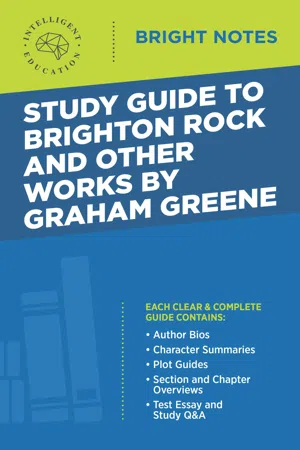
- English
- ePUB (mobile friendly)
- Available on iOS & Android
Study Guide to Brighton Rock and Other Works by Graham Greene
About this book
A comprehensive study guide offering in-depth explanation, essay, and test prep for selected works by Graham Greene, winner of Britain's Order of Merit and the Shakespeare Prize. Titles in this study guide include Brighton Rock, The Power and the Glory, The Heart of the Matter, The Quiet American, Burnt-Out Case, The Comedians, The Little Train, The Potting Shed, The Lawless Roads, The Lost Childhood, Stamboul Train, The Third Man, The Confidential Agent, Our Man in Havana, and The End of the Affair.As one of the leading English novelists of the twentieth-century, Greene's writings assisted in shaping contemporary catholic literature. Moreover, his thriller novels included philosophical and religious themes in order to explore the moral and political issues of the modern world. This Bright Notes Study Guide explores the context and history of Graham Greene's classic work, helping students to thoroughly explore the reasons they have stood the literary test of time. Each Bright Notes Study Guide contains: - Introductions to the Author and the Work
- Character Summaries
- Plot Guides
- Section and Chapter Overviews
- Test Essay and Study Q&AsThe Bright Notes Study Guide series offers an in-depth tour of more than 275 classic works of literature, exploring characters, critical commentary, historical background, plots, and themes. This set of study guides encourages readers to dig deeper in their understanding by including essay questions and answers as well as topics for further research.
Frequently asked questions
- Essential is ideal for learners and professionals who enjoy exploring a wide range of subjects. Access the Essential Library with 800,000+ trusted titles and best-sellers across business, personal growth, and the humanities. Includes unlimited reading time and Standard Read Aloud voice.
- Complete: Perfect for advanced learners and researchers needing full, unrestricted access. Unlock 1.4M+ books across hundreds of subjects, including academic and specialized titles. The Complete Plan also includes advanced features like Premium Read Aloud and Research Assistant.
Please note we cannot support devices running on iOS 13 and Android 7 or earlier. Learn more about using the app.
Information

- First Period (1929-1935): During this early period, Greene wrote The Man Within (1929), It’s A Battlefield (1934), and England Made Me (1935). These are rather hard to classify with any degree of precision. They deal with crime studied from a social and political standpoint, and it was in these works that Greene made his initial experiments in dealing with the psychology of his characters.
- Second Period (1938-1951): We shall be studying in detail the first three novels of this period, namely Brighton Rock (1938), The Power and the Glory (1940), and The Heart of the Matter (1948). These three novels constitute the main body of what we can call Greene’s religious writings, and they have in common the central themes that fascinate Greene-sin and salvation. By examining man’s relationship to himself, society, and God, Greene explores the nature of evil, and the possibility of man’s redemption. In many ways these novels contain the elements of crime stories-particularly the “manhunt” theme. But their contents assume spiritual dimensions which place them with the best of modern fiction. In Brighton Rock, for example, the main character, Pinkie, is a young gangster on the run from the police, a gang, a woman - and ultimately from God. Pinkie seems incapable of loving or of redemption - but Greene takes that assumption and examines it in all its aspects. The “chase” theme is also central to The Power and the Glory, where a corrupt “whiskey priest” is tormented by a ruthless lieutenant, by his own guilt-and again by God. In The Heart of the Matter, Greene examines the process involved in the total collapse of Scobie, a police officer whose warped sense of Christian pity drives him to self-destruction. While The End of the Affair (1951) falls into this period, it does not match the intensity and quality of the first three.
- Third Period (1955 - ): It is too early to attempt a clear-cut classification of the novels of this period, which include the Burnt Out Case (1961) and The Comedians (1966). It is interesting to observe, however, that the first novel of this period, The Quiet American (1955), while not specifically religious in theme, deals with the destruction of a human being who is apparently doomed by a kind of moral innocence.
- Novels: The Man Within (1929), It’s A Battlefield (1934), England Made Me (1935), Brighton Rock (1938), The Power and the Glory (The Labyrinthine Ways) (1940), The Heart of the Matter (1948), The End of the Affair (1951), The Quiet American (1955), The Burnt Out Case (1961), and The Comedians (1966).
- Short Stories: The Basement Room (1935), Nineteen Stories (1947), Twenty-one Stories (1954), and A Sense of Reality (1963).
- Essays and Journals: The Lost Childhood (1951) and In Search of a Character (1961).
- Travel: Journey Without Maps (1936), and The Lawless Roads (Another Mexico) (1939).
- Plays: The Living Room (1953), The Potting Shed (1957), The Complaisant Lover (1959), and Carving A Statue (1964).
- Entertainments: Stamboul Train (Orient Express) (1932), This Gun for Hire (A Gun for Sale) (1936), The Confidential Agent (1939), The Ministry of Fear (1943), The Third Man (1950), The Fallen Idol (1950), Loser Take All (1955), and Our Man in Havana (1958).
- Children’s Stories (with Dorothy Craigie): The Little Train (1947), The Little Fire Engine (1950), The Little Horse Bus (1952), and The Little Steam Roller (1953).
- Poems: Babbling April (1925).

Table of contents
- Front Cover
- Title Page
- Copyright Page
- Contents
- 1) Introduction to Graham Greene
- 2) Modern Catholic Literature
- 3) Greene And The Contemporary English Novel
- 4) Greene And The Heroic Ideal In Literature
- 5) Greene’s “Entertainments”
- 6) Greene’s Religious Trilogy
- 7) Brighton Rock
- 8) The Power and the Glory
- 9) The Heart of the Matter
- 10) Critical Commentary
- 11) Various Aspects Of Greene Criticism: Part 2
- 12) Bibliography